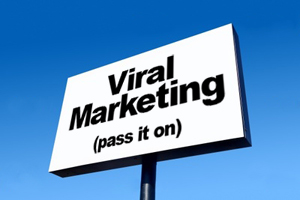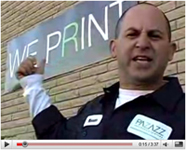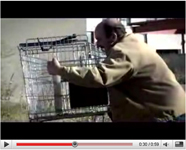Viral Marketing
By Kris Themstrup In Studies & Stats, Viral Marketing
Online, word of mouth can take on a life of its own. Social media, including blogs, videos, social networking and social bookmarking can tap into a massive user base unrivaled in the traditional marketing models. But it’s a thin line to walk when embarking on an online campaign, and the sales pitch has to take a back seat to the quality of the content to truly be effective. When word of mouth really builds steam and spreads across the net from user to user, and the content is created to specifically do that, it’s called viral marketing. The comparison to how a virus spreads throughout the body is often made, and if done correctly, this form of marketing can have a tremendous impact on the bottom line.
Let’s talk about two aspects of viral marketing; first, how to go about creating effective content and starting the fire, and second, some examples of successful viral campaigns and what steps they took.
Starting the Campaign: When entering into a viral marketing campaign, it’s important to understand that there’s no chance of success unless you have killer content. Whatever that content may be, it has to hold some kind of interest for the average user and also prompt them to circulate the message to friends, family and other users. There are a few different formats of content you can start with, such as text, pictures, videos, and podcasts. Images, podcasts and videos typically have the best success rate, just because it’s more likely for people to view an image, watch a video or listen to something rather than take the time to read a story. Although it’s still possible with the text format, it’s much more difficult.
When it comes to the question of what kind of content should be used, typically we don’t want to be too obvious with the message of selling. A direct sales approach won’t get very far in the viral sense, because users are quick to disregard messages they are bombarded with on a regular basis. It’s typically the humorous, weird, or sexy campaigns that hold the most interest for users and will have the best chance to reach a wider audience. Some messages are professionally done, some are simple, cheap and still just as effective. A marketing budget doesn’t automatically make or break a campaign, but it certainly can help. We still want to ensure the people our message reaches understand where it’s coming from, and what its promoting, but only as an after thought or as a subtle part of the message – it definitely shouldn’t be the main theme or again, there’s much less chance for success.
Once the content is created, it’s time to find the places to launch the campaign. Popular websites like YouTube, Digg and Facebook are good places to start, as they incorporate user-generated engines or applications and have part of their main focus towards the most popular content (with the goal of generating more traffic for both themselves and the source of the content). Putting the message on a blog will allow social media integration with bookmarking and networking sites, so it has the ability to be forwarded and shared frequently and easily. Start with several different places, and get ready to start the fire by contacting everyone in your network with the information for the message. This means emails, social networking profiles, social bookmarking sites, random people on the street, everywhere possible, and more. If done correctly, the viral domino effect should start slowly and quickly escalate, reaching friends of friends all across the net with your message.
It Works: Here’s some examples of some successful viral campaigns, what they did, and their results.
 1. Pazazz PrintingPazazz is a printing company from Montreal, and wanted to convey its love for printing and make people laugh. The 3 minute video is edgy, was done with very small budget, and received well over 150,000 views on YouTube. The company seeded the video in a viral campaign by sending it to the company database, setting up a YouTube, Facebook and LinkedIn profile, and doing press releases. The video got some great feedback from others in the industry and landed the CEO a speaking role at a major conference, along with generating over 800 emails to the company. The Video: Printing’s Alive | The Company: Pazazz.com 1. Pazazz PrintingPazazz is a printing company from Montreal, and wanted to convey its love for printing and make people laugh. The 3 minute video is edgy, was done with very small budget, and received well over 150,000 views on YouTube. The company seeded the video in a viral campaign by sending it to the company database, setting up a YouTube, Facebook and LinkedIn profile, and doing press releases. The video got some great feedback from others in the industry and landed the CEO a speaking role at a major conference, along with generating over 800 emails to the company. The Video: Printing’s Alive | The Company: Pazazz.com |
 2. Facebook “Wendy”This blonde generated a huge buzz on Facebook after a profile was set up claiming that a digital camera was found containing her pictures, and those who found it were trying to find her to return her property. The pictures were pretty racy, some even nude. People (mostly men) all over the world remarkably came to the rescue by offering their help in locating the mystery girl at the rate of 1 every 5 seconds. It turned out to be a very clever viral campaign started by a porn site, and the model turned out to be a professional adult entertainer. The Story: Facebook Phenomenom 2. Facebook “Wendy”This blonde generated a huge buzz on Facebook after a profile was set up claiming that a digital camera was found containing her pictures, and those who found it were trying to find her to return her property. The pictures were pretty racy, some even nude. People (mostly men) all over the world remarkably came to the rescue by offering their help in locating the mystery girl at the rate of 1 every 5 seconds. It turned out to be a very clever viral campaign started by a porn site, and the model turned out to be a professional adult entertainer. The Story: Facebook Phenomenom |
 3. The Cart WhispererVeriSign wanted a way to communicate the message to e-commerce website owners that they understand the issue of abandoned shopping carts, and if a website had a security system (preferably from VeriSign), this would happen less. Enter Liberty Fillmore, a fictional character known as “The Cart Whisperer”. This series of YouTube videos about Liberty and his quest to rescue abandoned shopping carts generated over 3 million views on YouTube alone. A website was set up, featuring poetry, pictures, a bio, and the character was complete. MySpace and Facebook profiles were integrated and the videos were launched with banners and other paid advertising models. The website generated over 90,000 unique visitors and the campaign got a ton of coverage from the blogosphere. The Videos: Liberty Fillmore on YouTube | The Website: NoMoreAbandonedCarts.com 3. The Cart WhispererVeriSign wanted a way to communicate the message to e-commerce website owners that they understand the issue of abandoned shopping carts, and if a website had a security system (preferably from VeriSign), this would happen less. Enter Liberty Fillmore, a fictional character known as “The Cart Whisperer”. This series of YouTube videos about Liberty and his quest to rescue abandoned shopping carts generated over 3 million views on YouTube alone. A website was set up, featuring poetry, pictures, a bio, and the character was complete. MySpace and Facebook profiles were integrated and the videos were launched with banners and other paid advertising models. The website generated over 90,000 unique visitors and the campaign got a ton of coverage from the blogosphere. The Videos: Liberty Fillmore on YouTube | The Website: NoMoreAbandonedCarts.com |
These campaigns are examples of ideas that worked; taking something the public finds interesting and allowing them to take it and run with it. To be able to start a viral campaign, ensure you have great content and the right platform to distribute it through. For more information on creating business blogs, press releases and social media advertising, which all can be helpful in a viral marketing campaign, visit iePlexus.com.


Shane Dougherty
Thank you Kris for your research on this very important component of a successful Web 2.0 campaign.
Audie
Don’t forget about NIKE. One of the all time greatest virals ever, with more than 50 million views globally features famous soccer star Ronaldinho.
Debt Girl
well viral strategy demands really great blonde.
Marie Piascik
Great article, and thanks for taking the effort to publish it; I’m sure otheres benefited also. It really opened my eyes for some new ideas that I hadn’t thought of before.